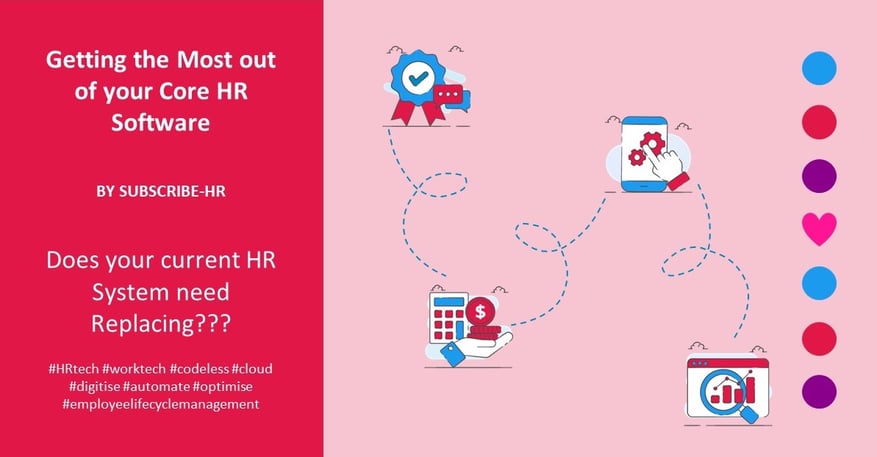If you’re reading this, it may be because you’ve recently implemented a Core HR system, and you’re wondering how you can use it to completely hack your HR. 🤔
Core HR systems can be incredibly powerful, but if you don’t know how to make the most out of them, it can be tricky to get them to perform to their full potential.
In this blog post, we’ll be telling you everything you need to know about optimising your Core HR system for out-of-this-world HR performance!
Read on if you want to find out:
- What a Core HR strategy is
- How you can make your HR department better
- What a good HR system looks like
- How to make the most out of your Core HR system
- The exact strategies you can use to level-up your Core HR

Why Core HR Systems are the Future
What are Core HR systems?
Core HR encompasses the fundamental tasks of an HR department – all the intricacies of recruiting, onboarding, managing, developing, compensating employees, and more.
An HR core system represents a suite of advanced software and tools meticulously crafted to streamline and optimise essential HR functions. Leveraging the power of technology, these systems adeptly handle and process critical employee data, ensuring a seamless flow of HR processes while enhancing overall productivity. 👍
Some key advantages of having a Core HR system include ⬇️
- Streamlined and automated processes
- Better internal communication
- Centralised data storage
- Enhanced privacy and security
- Actionable insights through data analytics
- Comprehensive employee record keeping
- Accurate payroll processing
- Better performance management
- Regulatory compliance
- More employee engagement
- And so much more!

What is a core HR strategy?
A Core HR strategy involves aligning human resource practices with overall organisational goals. 🎯
It encompasses fundamental HR functions like recruitment, onboarding, performance management, and employee relations. A robust core HR strategy will be able to optimise these processes, ensuring they contribute to the organisation's success and employee satisfaction. 🙌
What does a good HR system look like?
In our opinion here at Subscribe-HR, a good HR system should have the following attributes 👇
- A user-friendly interface for easy navigation and accessibility for all users
- Comprehensive functionality covering key HR areas like recruitment, onboarding, performance management, and payroll
- Integration capabilities for seamless integration with other organisational tools and systems
- Data security measures to ensure the confidentiality and security of sensitive employee information
- Scalability for the ability to adapt and scale with your organisation's growth
- Analytics and reporting to provide actionable insights through data analytics for informed decision-making
- Compliance features that support adherence to legal and regulatory requirements
- Employee self-service that allows employees to manage their HR-related tasks independently
7 Strategies for Optimising Your Core HR System
Here are our 7 favourite strategies to make the most out of your Core HR system ⬇️
Comprehensively training your team on Core HR systems
The point of training your team on Core HR systems in an in-depth way helps not only to familiarise but to empower your workforce, enabling them to navigate the system with ease and extract maximum value from every feature it offers 👍
Customised training modules
A good idea here is to offer customised training modules so that you can tailor your team’s learning to their specific roles. This ensures the relevance of the training, enhances engagement, and accelerates proficiency in areas directly applicable to their individual roles.
Learning by doing
It’s useful to incorporate practical, hands-on workshops where employees can actively use the Core HR system in simulated scenarios. This encourages applied learning, builds confidence, and facilitates a deeper understanding of system functionalities.
Continuous learning
Another good practice is to implement ongoing training programs, including regular refresher courses and advanced sessions, to keep the team updated on system updates. 👏

Fully customising your Core HR system to your unique needs
Part of the beauty of Core HR systems lies in the huge potential for customisation. This is really exciting for us HR software nerds because it means you can curate a system that is entirely moulded to your exact needs. 🙌
- Start by analysing your needs. Conduct a thorough needs assessment to identify specific organisational requirements, pain points, and preferences
- Map existing workflows and processes within the organisation, identifying key touchpoints and dependencies
- Involve key stakeholders, including HR professionals, department heads, and end-users, in the customisation process
- Prioritise customisation elements that enhance the user experience, considering user preferences and ease of navigation
- Align customisation with regulatory and compliance requirements relevant to your organisation's industry and location
The rule of thumb here is that the more you customise your Core HR system, the better it can make life easier for your HR team down the line!
Integrating with other tools
If you feel like your Core HR system is a bit lacklustre, it may be because you haven’t integrated it with other key tools in your workflow.
Start by assessing your integration needs
Conduct an exhaustive assessment of existing tools and systems used across the organisation. Literally list any tool your HR team uses, from payroll processing to compliance.
Check out integration compatibility for each tool
Evaluate the compatibility of each tool with the Core HR system by reviewing technical specifications and documentation of the Core HR system. You can also assess API availability and compatibility of existing tools.
Select the integration methods
Choose the most suitable integration method based on system compatibility and requirements. Depending on your Core HR system, you can choose from ⬇️
- API (Application Programming Interface), through RESTful or SOAP APIs
- Middleware Integration to connect Core HR with various tools in the workflow
- Pre-built Connectors specifically designed to connect their applications with other popular tools
- FTP (File Transfer Protocol)
- Webhooks
- Message Queues
- OAuth (Open Authorisation)
- Event-Driven Architecture
- GraphQL Integration
- Custom Code Integration
- Data Replication
💡 Here at Subscribe-HR, we help HR leaders totally streamline their integration process by letting them integrate their tools in just a few clicks. You can find out more here!
Integrate your tools and document progress
A lot can happen when going through the process of tool integration, so make sure you keep a log of your progress for each tool in your workflow, detailing what was done and when.
Test the integrations
Conduct thorough testing to identify and resolve any issues before full implementation. You can do this by setting up a testing environment that mirrors the live workflow and executing test scenarios to validate data exchange and system behaviour.
Implement the integration
Roll out the integrated workflow in a phased approach or all at once by scheduling a specific implementation window and monitoring the transition and address any issues promptly.

Prioritising a user-friendly interface
Your Core HR system will perform infinitely better if it is built with your team in mind.
Personalised dashboards
Implement customisable dashboards that allow users to arrange and prioritise information according to their roles and preferences.
Provide drag-and-drop functionality, widgets, or modules that enable users to tailor their dashboard to display the most relevant data. ✅
Interactive tutorials and guides
Develop interactive tutorials and guides embedded within the Core HR system to assist users in exploring features and functionalities.
Include tooltips, walkthroughs, and pop-up guides that offer contextual help, ensuring users can easily understand and utilise system features.
Role-based access
Tailor the interface based on user roles, providing each role with access to the specific features and data relevant to their responsibilities. Define role-based permissions and configurations to customise the user experience for different HR team members.
Going all out on data security and compliance measures
Core HR systems have the potential to take the hard work out of compliance and data security, so it’s important to thoroughly consider this when implementing your software.
You can do this through a few different ways ⬇️
- Multi-factor authentication (MFA) – Enhance access security by implementing multi-factor authentication, requiring users to verify their identity through multiple verification methods
- Role-Based Access Control (RBAC) – Implement RBAC to restrict access to data based on user roles, ensuring that each user can only access information relevant to their responsibilities
- Audit Trails and Logging – Enable comprehensive audit trails and logging mechanisms to track user activities within the Core HR system
- Regular security audits – Conduct regular security audits to identify vulnerabilities, assess risks, and ensure that security measures remain robust
- Vendor security assessments – If using third-party vendors for the Core HR system, conduct thorough security assessments to ensure their systems meet your security standards
- Incident response plan – Develop a robust incident response plan to effectively address and mitigate security incidents or data breaches
- Data backups and recovery – Implement regular data backups and recovery mechanisms to prevent data loss in the event of a security incident
- Privacy Impact Assessments (PIA) – Conduct PIAs to identify and address potential privacy risks associated with the collection and processing of personal information
👉 It may also be a good idea to seek legal consultation to ensure that your Core HR system complies with relevant employment and privacy laws.

Implementing user feedback mechanisms
Your Core HR system grows as your team uses it, so it’s important to implement a solid user feedback mechanism. 👇
Choose your feedback collection channels
Implement diverse channels for collecting user feedback to ensure accessibility and inclusivity. Utilise surveys, suggestion boxes, in-app feedback forms, and regular focus group sessions to capture a wide range of perspectives and preferences.
Real-time feedback options
Provide real-time feedback options within the Core HR system, allowing users to express opinions immediately after using a feature or encountering an issue.
Feedback analytics and tracking
Employ analytics tools to track and analyse feedback trends over time, identifying recurring issues or popular suggestions. Use analytics dashboards to visualise feedback data, categorise responses, and prioritise areas for improvement based on quantitative and qualitative insights.
Anonymous feedback
Establish mechanisms for anonymous feedback to encourage honest and unbiased opinions, especially on sensitive topics. Allow users to submit feedback anonymously, ensuring confidentiality and increasing the likelihood of receiving candid insights.
Feedback gamification
Introduce gamification elements to incentivise users to provide feedback by turning it into a rewarding and engaging activity. Implement features such as feedback badges, leaderboard recognition, or small rewards for users who actively contribute valuable insights.
Regular feedback surveys
Conduct regular, structured feedback surveys to gather in-depth insights on specific aspects of the Core HR system. Design surveys with a mix of open-ended and closed-ended questions, covering usability, feature satisfaction, and overall user experience.
Feedback response mechanism
Implement a transparent mechanism for responding to user feedback, keeping users informed about the status of their suggestions or reported issues.
Continuous improvement cycles
Establish iterative improvement cycles, consistently incorporating user feedback into regular system updates. Schedule frequent release cycles that include user-suggested enhancements, ensuring that the Core HR system evolves in response to user needs and expectations.

Including employee self-service options
In our opinion, employee self-service options are a feature that can hugely level-up your experience of implementing a Core HR system. It has a myriad of benefits that are too good to pass up on. 👀
Some of our strategies for employee self-service within Core HR systems are ⬇️
- Multi-functional employee dashboards – Develop interactive employee dashboards that serve as centralised hubs for various self-service functionalities. Include widgets for leave requests, personal information updates, training registrations, and benefits selections, providing a holistic view of HR-related activities
- Intuitive leave management options – if your Core HR system has the option, Incorporate visual calendars, leave balance summaries, and real-time status updates, enabling employees to navigate leave-related tasks with clarity and ease
- Personal information portals – Establish dedicated portals for employees to manage their personal information securely and independently. Provide editable fields for contact details, emergency contacts, and other personal data, allowing employees to keep their information up-to-date without HR intervention
- Learning & development – Extend self-service capabilities to learning and development activities, enabling employees to initiate training requests and track their professional development
- Automated benefits enrolment & management – Automate benefits enrollment processes, allowing employees to explore, select, and manage their benefits without manual intervention
- Real-time payroll information – Provide employees with real-time access to their payroll information, promoting transparency and reducing payroll-related queries
- Employee communication portal – Establish communication portals where employees can access company-wide announcements, policy updates, and internal communications
- Personalised task management workflows – Implement personalised task management workflows, allowing employees to receive and manage HR-related tasks efficiently
💡 Want to read more HR tips and tricks? Check out Subscribe-HR’s free guide to storytelling in HR!
FAQs – Frequently Asked Questions
What are Core HR systems, and why are they essential for HR management?
Core HR systems encompass fundamental HR tasks, from recruitment to employee development. They provide advanced software and tools to streamline HR functions. Leveraging technology, these systems optimise processes, ensuring seamless HR operations and heightened productivity.
What are the key advantages of having a Core HR system?
Core HR systems offer numerous benefits, including streamlined and automated processes, improved internal communication, centralised data storage, enhanced privacy and security, actionable insights through data analytics, comprehensive employee record keeping, accurate payroll processing, better performance management, regulatory compliance, increased employee engagement, and more.
What is a Core HR strategy, and why is it crucial for organisational success?
Core HR strategy involves aligning HR practices with organisational goals, optimising fundamental functions like recruitment and performance management. A robust strategy ensures that HR processes contribute to organisational success and employee satisfaction.
What attributes define a good HR system, according to Subscribe-HR?
A good HR system, according to Subscribe-HR, should have attributes such as a user-friendly interface, comprehensive functionality covering key HR areas, integration capabilities, data security measures, scalability, analytics and reporting, compliance features, and employee self-service options.
What are the strategies for optimising a Core HR system?
Strategies for optimising a Core HR system include comprehensive team training, customisation for unique needs, integration with other tools, prioritising a user-friendly interface, implementing data security and compliance measures, establishing user feedback mechanisms, and incorporating employee self-service options.
How can team training on Core HR systems be made more effective?
Enhance team proficiency by offering customised training modules, incorporating practical learning through hands-on workshops, and implementing continuous learning with regular refresher courses and advanced sessions.
How can a Core HR system be customised to meet specific organisational needs?
Customise a Core HR system by conducting a thorough needs assessment, mapping existing workflows, involving key stakeholders in the customisation process, prioritising elements that enhance user experience, and aligning customisation with regulatory requirements.
What integration methods can be used to connect a Core HR system with other tools?
Integration methods include API (RESTful or SOAP), middleware integration, pre-built connectors, FTP, webhooks, message queues, OAuth, event-driven architecture, GraphQL integration, and custom code integration.
How can data security and compliance measures be implemented in a Core HR system?
Implement measures such as multi-factor authentication, role-based access control, audit trails, regular security audits, vendor security assessments, incident response plans, data backups and recovery, and privacy impact assessments.
What role does user feedback play in optimising a Core HR system?
User feedback is crucial for continuous improvement. Implement diverse channels for feedback collection, provide real-time feedback options, utilise feedback analytics, encourage anonymous feedback, introduce feedback gamification, conduct regular surveys, establish a transparent feedback response mechanism, and incorporate insights into system updates.
How can employee self-service options be effectively implemented in a Core HR system?
Implement multi-functional employee dashboards, intuitive leave management options, personal information portals, learning and development features, automated benefits enrolment and management, real-time payroll information access, employee communication portals, personalised task management workflows, and FAQ sections.

